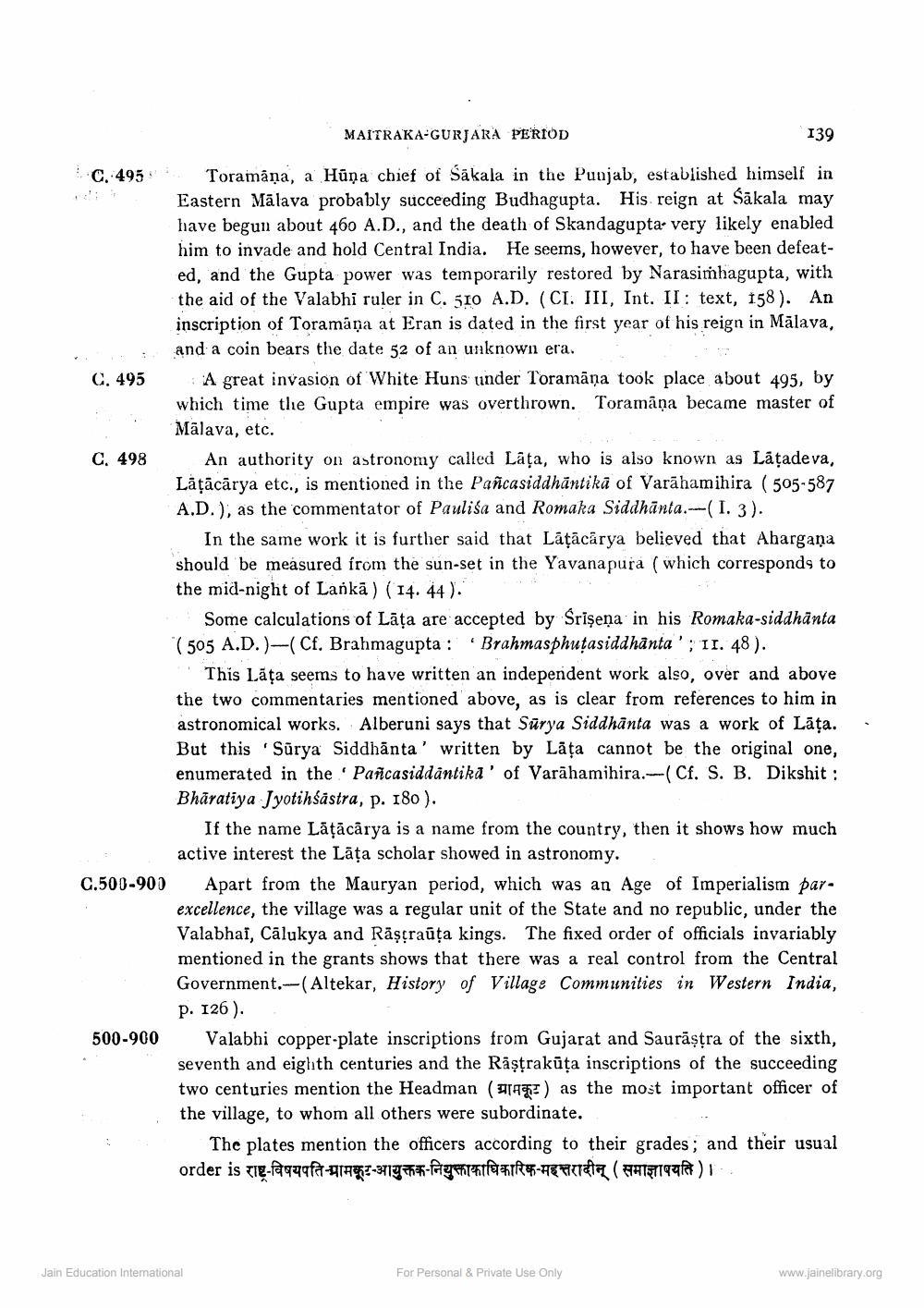________________
MAITRAKA-GURJARA PERIOD
139
C. 495 Toramâna, a Hūņa chief of Sākala in the Punjab, established himself in
Eastern Mālava probably succeeding Budhagupta. His reign at Sākala may have begun about 460 A.D., and the death of Skandagupta very likely enabled him to invade and hold Central India. He seems, however, to have been defeated, and the Gupta power was temporarily restored by Narasimhagupta, with the aid of the Valabhi ruler in C. 510 A.D. (CI. III, Int. II: text, 158). An inscription of Toramāņa at Eran is dated in the first year of his reign in Mālava,
and a coin bears the date 52 of an unknown era. C. 495 A great invasion of White Huns under Toramāna took place about 495, by
which time the Gupta empire was overthrown. Toramāņa became master of
Mālava, etc. C. 498 An authority on astronomy called Laţa, who is also known as Lăţadeva,
Lāțācārya etc., is mentioned in the Pancasiddhāntikā of Varāhamihira ( 505-587 A.D.), as the commentator of Paulisa and Romaka Siddhānta.--(1.3).
In the same work it is further said that Läţācārya believed that Ahargana should be measured from the sun-set in the Yavanapura ( which corresponds to the mid-night of Lankā) (14.44).
Some calculations of Lāța are accepted by Srişeņa in his Romaka-siddhānta (505 A.D.)–(Cf. Brahmagupta : Brahmasphutasiddhanta'; II. 48).
This Lāța seems to have written an independent work also, over and above the two commentaries mentioned above, as is clear from references to him in astronomical works. Alberuni says that Sürya Siddhanta was a work of Lāța. But this 'Sürya Siddhānta' written by Lăța cannot be the original one, enumerated in the Pancasiddantika' of Varāhamihira.---(Cf. S. B. Dikshit : Bhāratiya Jyotihśāstra, p. 180).
If the name Lățācārya is a name from the country, then it shows how much
active interest the Lāța scholar showed in astronomy. C.500-900 Apart from the Mauryan period, which was an Age of Imperialism par
excellence, the village was a regular unit of the State and no republic, under the Valabhai, Cālukya and Rāşçraūța kings. The fixed order of officials invariably mentioned in the grants shows that there was a real control from the Central Government.-(Altekar, History of Village Communities in Western India,
P. 126 ). 500-900 Valabhi copper-plate inscriptions from Gujarat and Saurāştra of the sixth,
seventh and eighth centuries and the Rāştrakūța inscriptions of the succeeding two centuries mention the Headman (14) as the most important officer of the village, to whom all others were subordinate.
The plates mention the officers according to their grades; and their usual order is राष्ट्र-विषयपति-ग्रामकूट-आयुक्तक-नियुक्ताकाधिकारिक-महन्तरादीन् ( समाज्ञापयति)। .
Jain Education Intemational
For Personal & Private Use Only
www.jainelibrary.org




